Leadership and Management Impact on Operations at Boots UK
VerifiedAdded on 2024/05/21
|27
|6028
|368
Report
AI Summary
This report provides an in-depth analysis of leadership and management roles within Boots UK, comparing the characteristics of leaders and managers and applying relevant theories such as Mintzberg's roles and behavioral management theory. It examines how these roles function in various situational contexts, including stable, slow-changing, and fast-changing environments, and evaluates different approaches like situational leadership and contingency theory. The report also explains key approaches to operations management, emphasizing the importance of leadership and management in achieving business objectives. Furthermore, it assesses how external factors impact operational management and decision-making, analyzing the relationship between leadership and management within Boots UK and its wider community, while also evaluating how leaders and managers can improve operational efficiencies to meet business goals.

MANAGEMENT AND OPERATIONS
18
18
Paraphrase This Document
Need a fresh take? Get an instant paraphrase of this document with our AI Paraphraser
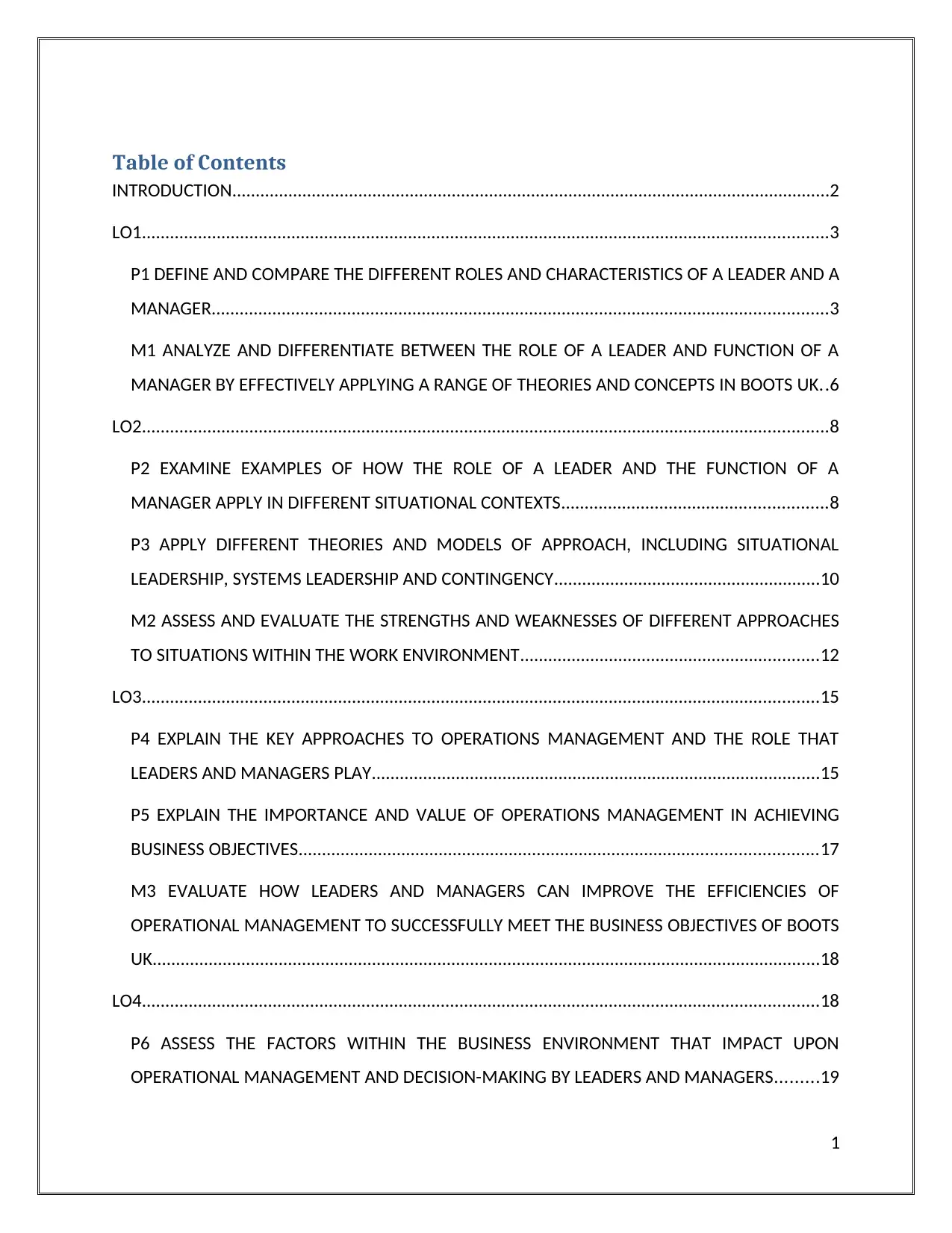
Table of Contents
INTRODUCTION................................................................................................................................2
LO1...................................................................................................................................................3
P1 DEFINE AND COMPARE THE DIFFERENT ROLES AND CHARACTERISTICS OF A LEADER AND A
MANAGER....................................................................................................................................3
M1 ANALYZE AND DIFFERENTIATE BETWEEN THE ROLE OF A LEADER AND FUNCTION OF A
MANAGER BY EFFECTIVELY APPLYING A RANGE OF THEORIES AND CONCEPTS IN BOOTS UK..6
LO2...................................................................................................................................................8
P2 EXAMINE EXAMPLES OF HOW THE ROLE OF A LEADER AND THE FUNCTION OF A
MANAGER APPLY IN DIFFERENT SITUATIONAL CONTEXTS.........................................................8
P3 APPLY DIFFERENT THEORIES AND MODELS OF APPROACH, INCLUDING SITUATIONAL
LEADERSHIP, SYSTEMS LEADERSHIP AND CONTINGENCY.........................................................10
M2 ASSESS AND EVALUATE THE STRENGTHS AND WEAKNESSES OF DIFFERENT APPROACHES
TO SITUATIONS WITHIN THE WORK ENVIRONMENT................................................................12
LO3.................................................................................................................................................15
P4 EXPLAIN THE KEY APPROACHES TO OPERATIONS MANAGEMENT AND THE ROLE THAT
LEADERS AND MANAGERS PLAY................................................................................................15
P5 EXPLAIN THE IMPORTANCE AND VALUE OF OPERATIONS MANAGEMENT IN ACHIEVING
BUSINESS OBJECTIVES...............................................................................................................17
M3 EVALUATE HOW LEADERS AND MANAGERS CAN IMPROVE THE EFFICIENCIES OF
OPERATIONAL MANAGEMENT TO SUCCESSFULLY MEET THE BUSINESS OBJECTIVES OF BOOTS
UK...............................................................................................................................................18
LO4.................................................................................................................................................18
P6 ASSESS THE FACTORS WITHIN THE BUSINESS ENVIRONMENT THAT IMPACT UPON
OPERATIONAL MANAGEMENT AND DECISION-MAKING BY LEADERS AND MANAGERS.........19
1
INTRODUCTION................................................................................................................................2
LO1...................................................................................................................................................3
P1 DEFINE AND COMPARE THE DIFFERENT ROLES AND CHARACTERISTICS OF A LEADER AND A
MANAGER....................................................................................................................................3
M1 ANALYZE AND DIFFERENTIATE BETWEEN THE ROLE OF A LEADER AND FUNCTION OF A
MANAGER BY EFFECTIVELY APPLYING A RANGE OF THEORIES AND CONCEPTS IN BOOTS UK..6
LO2...................................................................................................................................................8
P2 EXAMINE EXAMPLES OF HOW THE ROLE OF A LEADER AND THE FUNCTION OF A
MANAGER APPLY IN DIFFERENT SITUATIONAL CONTEXTS.........................................................8
P3 APPLY DIFFERENT THEORIES AND MODELS OF APPROACH, INCLUDING SITUATIONAL
LEADERSHIP, SYSTEMS LEADERSHIP AND CONTINGENCY.........................................................10
M2 ASSESS AND EVALUATE THE STRENGTHS AND WEAKNESSES OF DIFFERENT APPROACHES
TO SITUATIONS WITHIN THE WORK ENVIRONMENT................................................................12
LO3.................................................................................................................................................15
P4 EXPLAIN THE KEY APPROACHES TO OPERATIONS MANAGEMENT AND THE ROLE THAT
LEADERS AND MANAGERS PLAY................................................................................................15
P5 EXPLAIN THE IMPORTANCE AND VALUE OF OPERATIONS MANAGEMENT IN ACHIEVING
BUSINESS OBJECTIVES...............................................................................................................17
M3 EVALUATE HOW LEADERS AND MANAGERS CAN IMPROVE THE EFFICIENCIES OF
OPERATIONAL MANAGEMENT TO SUCCESSFULLY MEET THE BUSINESS OBJECTIVES OF BOOTS
UK...............................................................................................................................................18
LO4.................................................................................................................................................18
P6 ASSESS THE FACTORS WITHIN THE BUSINESS ENVIRONMENT THAT IMPACT UPON
OPERATIONAL MANAGEMENT AND DECISION-MAKING BY LEADERS AND MANAGERS.........19
1
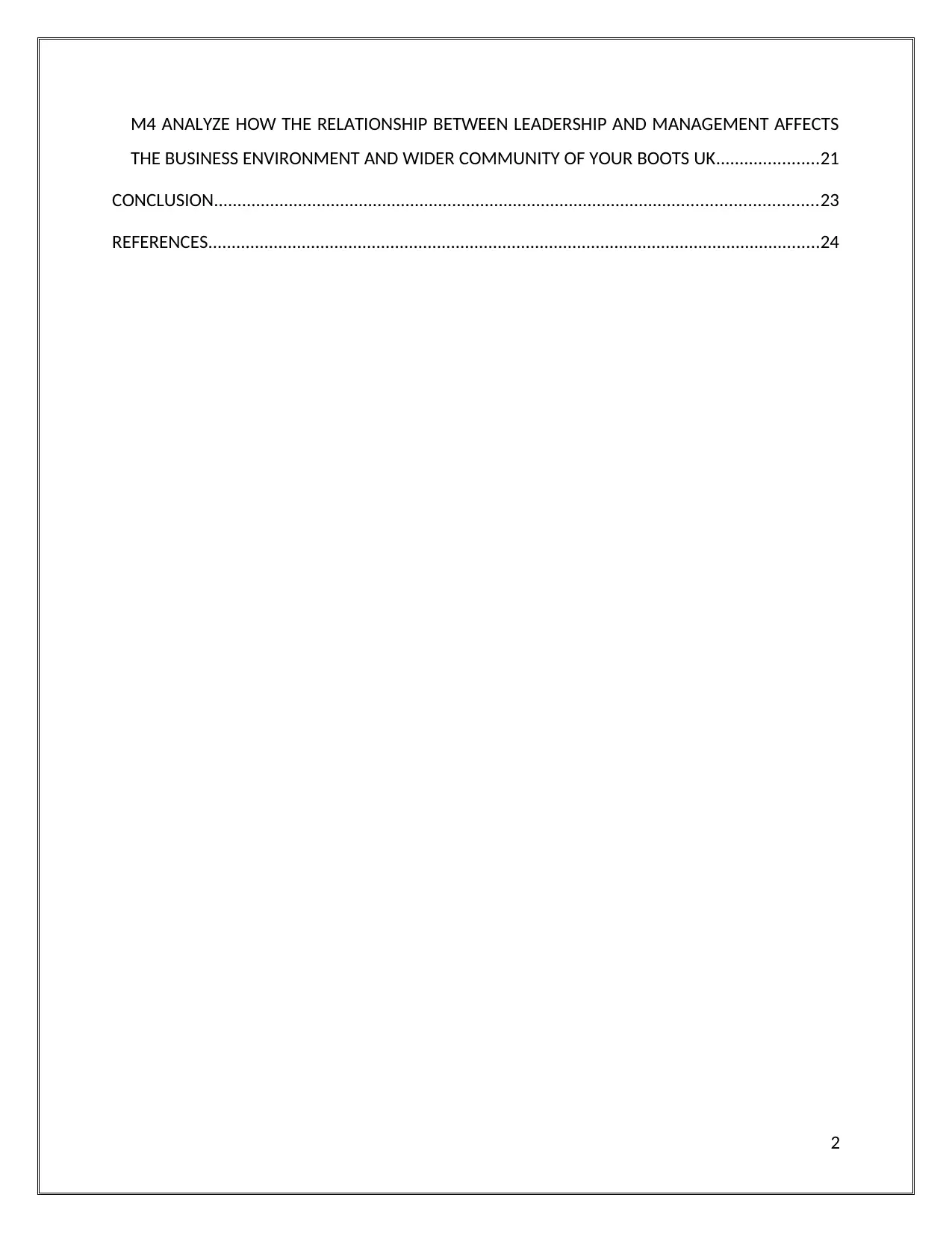
M4 ANALYZE HOW THE RELATIONSHIP BETWEEN LEADERSHIP AND MANAGEMENT AFFECTS
THE BUSINESS ENVIRONMENT AND WIDER COMMUNITY OF YOUR BOOTS UK......................21
CONCLUSION.................................................................................................................................23
REFERENCES...................................................................................................................................24
2
THE BUSINESS ENVIRONMENT AND WIDER COMMUNITY OF YOUR BOOTS UK......................21
CONCLUSION.................................................................................................................................23
REFERENCES...................................................................................................................................24
2
⊘ This is a preview!⊘
Do you want full access?
Subscribe today to unlock all pages.

Trusted by 1+ million students worldwide
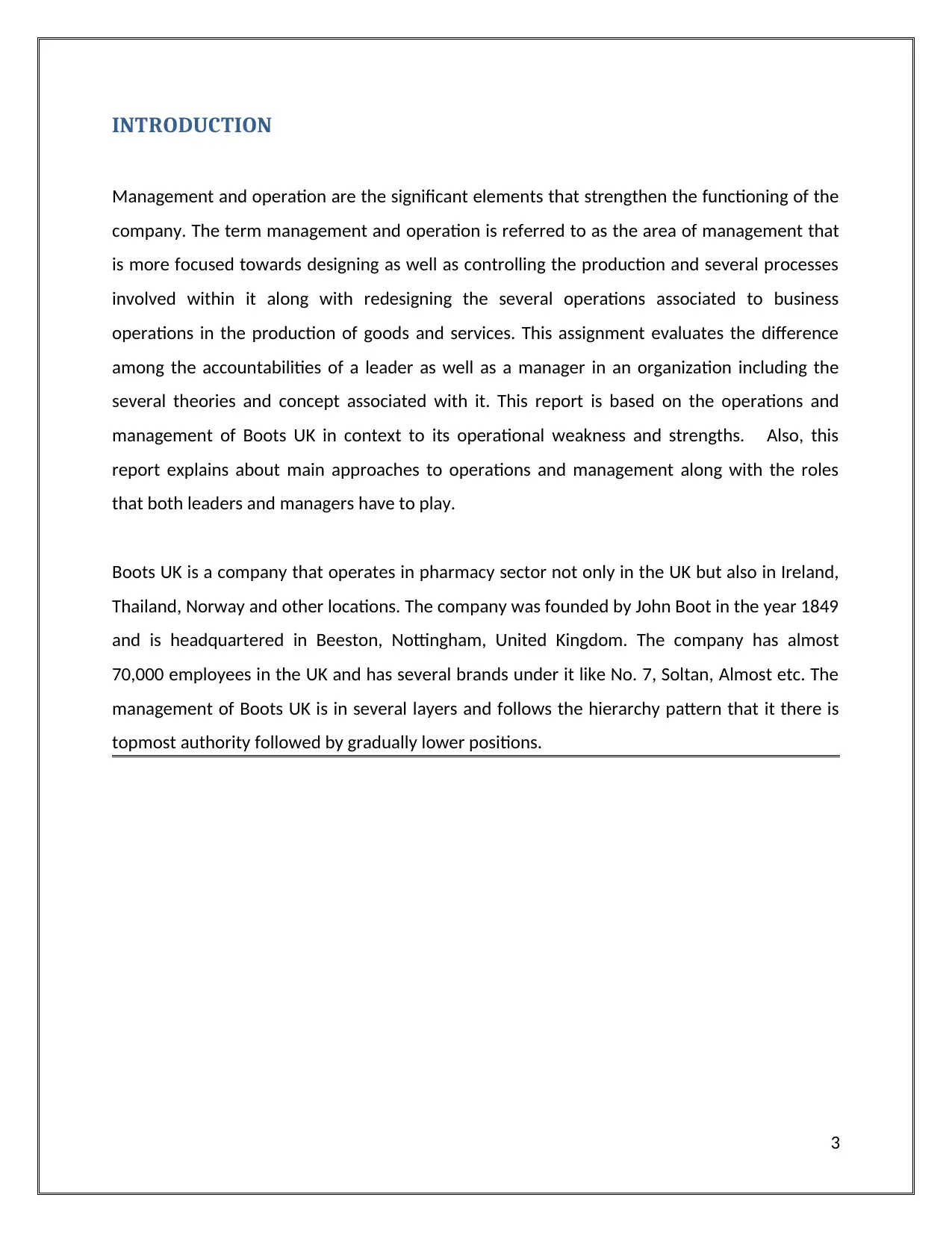
INTRODUCTION
Management and operation are the significant elements that strengthen the functioning of the
company. The term management and operation is referred to as the area of management that
is more focused towards designing as well as controlling the production and several processes
involved within it along with redesigning the several operations associated to business
operations in the production of goods and services. This assignment evaluates the difference
among the accountabilities of a leader as well as a manager in an organization including the
several theories and concept associated with it. This report is based on the operations and
management of Boots UK in context to its operational weakness and strengths. Also, this
report explains about main approaches to operations and management along with the roles
that both leaders and managers have to play.
Boots UK is a company that operates in pharmacy sector not only in the UK but also in Ireland,
Thailand, Norway and other locations. The company was founded by John Boot in the year 1849
and is headquartered in Beeston, Nottingham, United Kingdom. The company has almost
70,000 employees in the UK and has several brands under it like No. 7, Soltan, Almost etc. The
management of Boots UK is in several layers and follows the hierarchy pattern that it there is
topmost authority followed by gradually lower positions.
3
Management and operation are the significant elements that strengthen the functioning of the
company. The term management and operation is referred to as the area of management that
is more focused towards designing as well as controlling the production and several processes
involved within it along with redesigning the several operations associated to business
operations in the production of goods and services. This assignment evaluates the difference
among the accountabilities of a leader as well as a manager in an organization including the
several theories and concept associated with it. This report is based on the operations and
management of Boots UK in context to its operational weakness and strengths. Also, this
report explains about main approaches to operations and management along with the roles
that both leaders and managers have to play.
Boots UK is a company that operates in pharmacy sector not only in the UK but also in Ireland,
Thailand, Norway and other locations. The company was founded by John Boot in the year 1849
and is headquartered in Beeston, Nottingham, United Kingdom. The company has almost
70,000 employees in the UK and has several brands under it like No. 7, Soltan, Almost etc. The
management of Boots UK is in several layers and follows the hierarchy pattern that it there is
topmost authority followed by gradually lower positions.
3
Paraphrase This Document
Need a fresh take? Get an instant paraphrase of this document with our AI Paraphraser
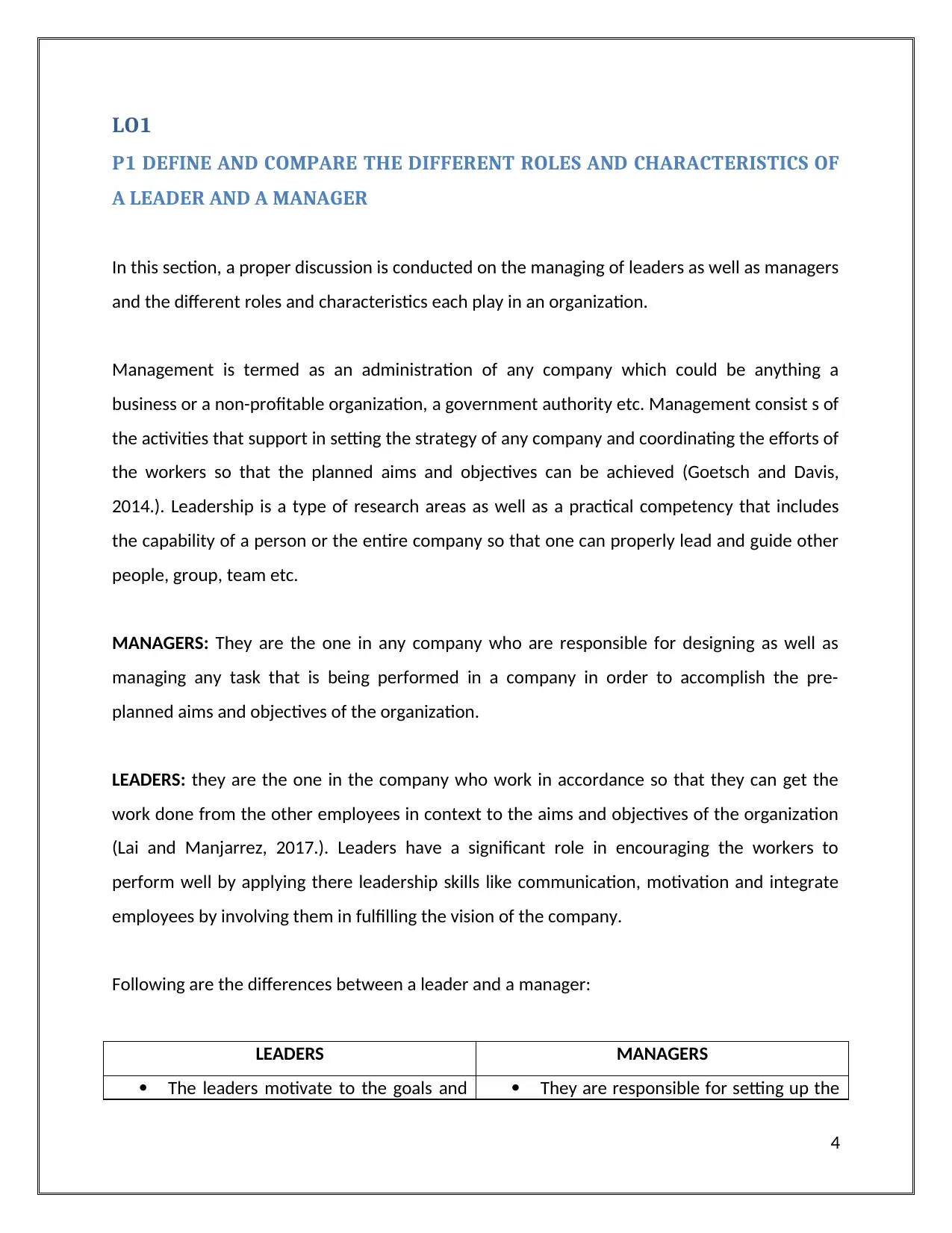
LO1
P1 DEFINE AND COMPARE THE DIFFERENT ROLES AND CHARACTERISTICS OF
A LEADER AND A MANAGER
In this section, a proper discussion is conducted on the managing of leaders as well as managers
and the different roles and characteristics each play in an organization.
Management is termed as an administration of any company which could be anything a
business or a non-profitable organization, a government authority etc. Management consist s of
the activities that support in setting the strategy of any company and coordinating the efforts of
the workers so that the planned aims and objectives can be achieved (Goetsch and Davis,
2014.). Leadership is a type of research areas as well as a practical competency that includes
the capability of a person or the entire company so that one can properly lead and guide other
people, group, team etc.
MANAGERS: They are the one in any company who are responsible for designing as well as
managing any task that is being performed in a company in order to accomplish the pre-
planned aims and objectives of the organization.
LEADERS: they are the one in the company who work in accordance so that they can get the
work done from the other employees in context to the aims and objectives of the organization
(Lai and Manjarrez, 2017.). Leaders have a significant role in encouraging the workers to
perform well by applying there leadership skills like communication, motivation and integrate
employees by involving them in fulfilling the vision of the company.
Following are the differences between a leader and a manager:
LEADERS MANAGERS
The leaders motivate to the goals and They are responsible for setting up the
4
P1 DEFINE AND COMPARE THE DIFFERENT ROLES AND CHARACTERISTICS OF
A LEADER AND A MANAGER
In this section, a proper discussion is conducted on the managing of leaders as well as managers
and the different roles and characteristics each play in an organization.
Management is termed as an administration of any company which could be anything a
business or a non-profitable organization, a government authority etc. Management consist s of
the activities that support in setting the strategy of any company and coordinating the efforts of
the workers so that the planned aims and objectives can be achieved (Goetsch and Davis,
2014.). Leadership is a type of research areas as well as a practical competency that includes
the capability of a person or the entire company so that one can properly lead and guide other
people, group, team etc.
MANAGERS: They are the one in any company who are responsible for designing as well as
managing any task that is being performed in a company in order to accomplish the pre-
planned aims and objectives of the organization.
LEADERS: they are the one in the company who work in accordance so that they can get the
work done from the other employees in context to the aims and objectives of the organization
(Lai and Manjarrez, 2017.). Leaders have a significant role in encouraging the workers to
perform well by applying there leadership skills like communication, motivation and integrate
employees by involving them in fulfilling the vision of the company.
Following are the differences between a leader and a manager:
LEADERS MANAGERS
The leaders motivate to the goals and They are responsible for setting up the
4
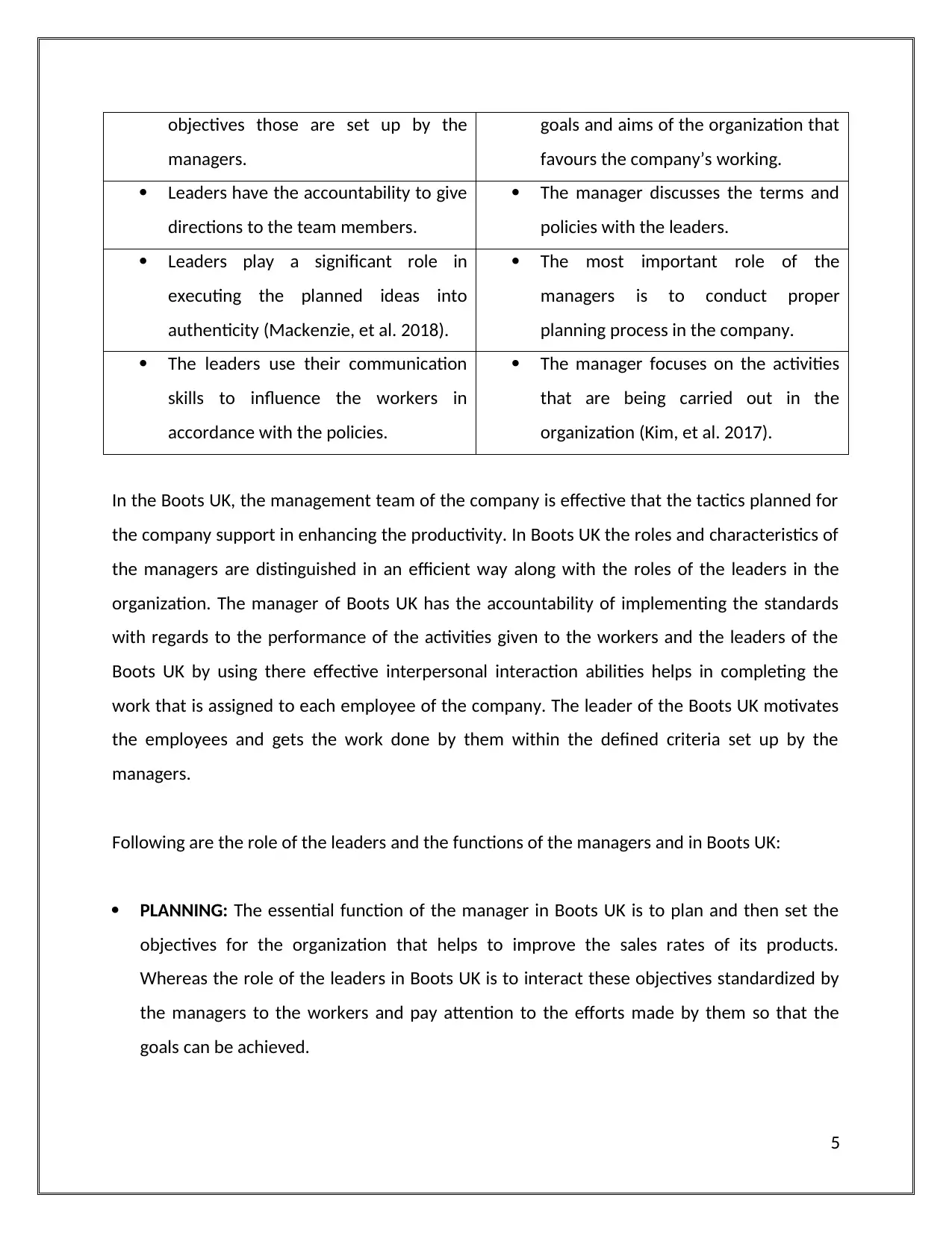
objectives those are set up by the
managers.
goals and aims of the organization that
favours the company’s working.
Leaders have the accountability to give
directions to the team members.
The manager discusses the terms and
policies with the leaders.
Leaders play a significant role in
executing the planned ideas into
authenticity (Mackenzie, et al. 2018).
The most important role of the
managers is to conduct proper
planning process in the company.
The leaders use their communication
skills to influence the workers in
accordance with the policies.
The manager focuses on the activities
that are being carried out in the
organization (Kim, et al. 2017).
In the Boots UK, the management team of the company is effective that the tactics planned for
the company support in enhancing the productivity. In Boots UK the roles and characteristics of
the managers are distinguished in an efficient way along with the roles of the leaders in the
organization. The manager of Boots UK has the accountability of implementing the standards
with regards to the performance of the activities given to the workers and the leaders of the
Boots UK by using there effective interpersonal interaction abilities helps in completing the
work that is assigned to each employee of the company. The leader of the Boots UK motivates
the employees and gets the work done by them within the defined criteria set up by the
managers.
Following are the role of the leaders and the functions of the managers and in Boots UK:
PLANNING: The essential function of the manager in Boots UK is to plan and then set the
objectives for the organization that helps to improve the sales rates of its products.
Whereas the role of the leaders in Boots UK is to interact these objectives standardized by
the managers to the workers and pay attention to the efforts made by them so that the
goals can be achieved.
5
managers.
goals and aims of the organization that
favours the company’s working.
Leaders have the accountability to give
directions to the team members.
The manager discusses the terms and
policies with the leaders.
Leaders play a significant role in
executing the planned ideas into
authenticity (Mackenzie, et al. 2018).
The most important role of the
managers is to conduct proper
planning process in the company.
The leaders use their communication
skills to influence the workers in
accordance with the policies.
The manager focuses on the activities
that are being carried out in the
organization (Kim, et al. 2017).
In the Boots UK, the management team of the company is effective that the tactics planned for
the company support in enhancing the productivity. In Boots UK the roles and characteristics of
the managers are distinguished in an efficient way along with the roles of the leaders in the
organization. The manager of Boots UK has the accountability of implementing the standards
with regards to the performance of the activities given to the workers and the leaders of the
Boots UK by using there effective interpersonal interaction abilities helps in completing the
work that is assigned to each employee of the company. The leader of the Boots UK motivates
the employees and gets the work done by them within the defined criteria set up by the
managers.
Following are the role of the leaders and the functions of the managers and in Boots UK:
PLANNING: The essential function of the manager in Boots UK is to plan and then set the
objectives for the organization that helps to improve the sales rates of its products.
Whereas the role of the leaders in Boots UK is to interact these objectives standardized by
the managers to the workers and pay attention to the efforts made by them so that the
goals can be achieved.
5
⊘ This is a preview!⊘
Do you want full access?
Subscribe today to unlock all pages.

Trusted by 1+ million students worldwide
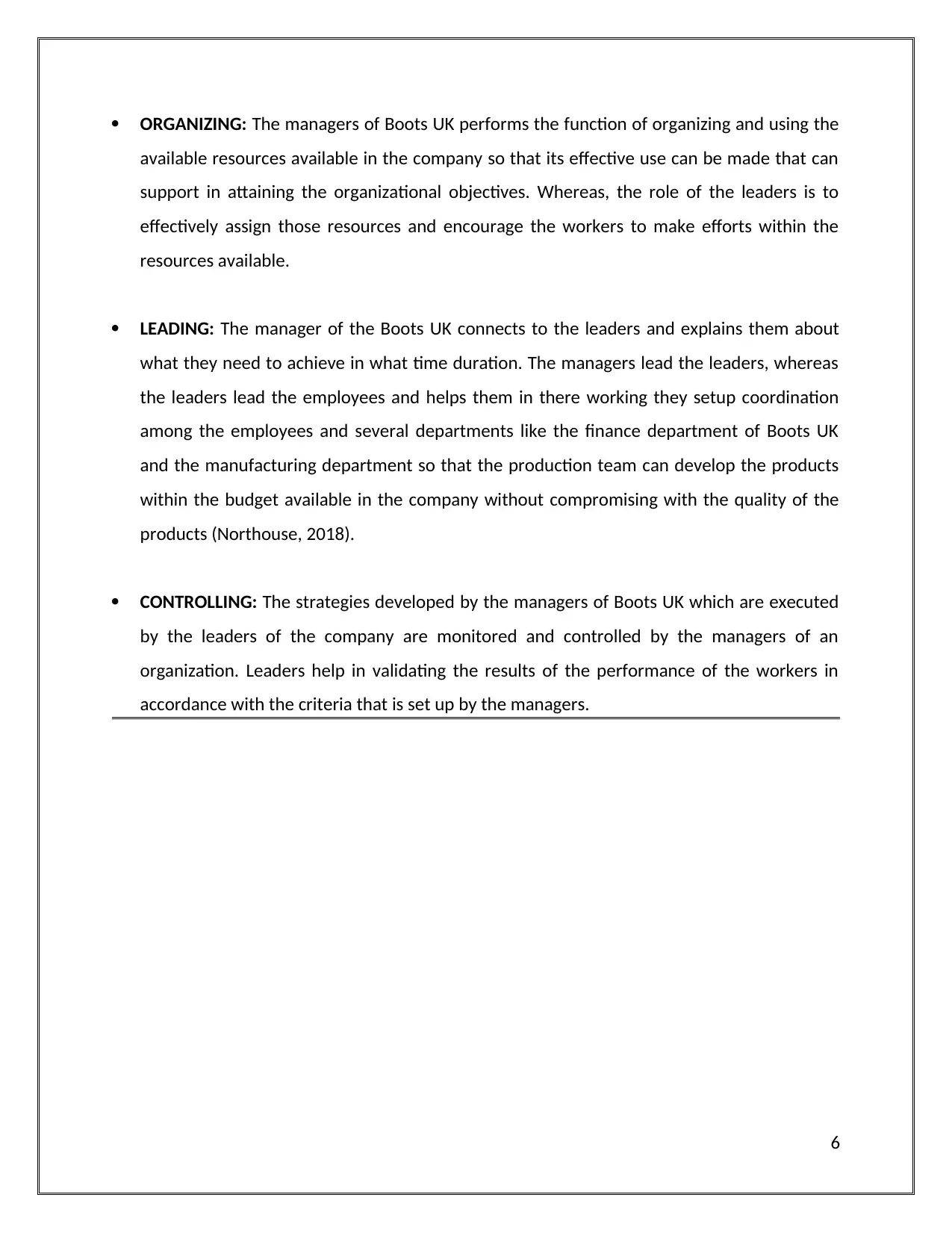
ORGANIZING: The managers of Boots UK performs the function of organizing and using the
available resources available in the company so that its effective use can be made that can
support in attaining the organizational objectives. Whereas, the role of the leaders is to
effectively assign those resources and encourage the workers to make efforts within the
resources available.
LEADING: The manager of the Boots UK connects to the leaders and explains them about
what they need to achieve in what time duration. The managers lead the leaders, whereas
the leaders lead the employees and helps them in there working they setup coordination
among the employees and several departments like the finance department of Boots UK
and the manufacturing department so that the production team can develop the products
within the budget available in the company without compromising with the quality of the
products (Northouse, 2018).
CONTROLLING: The strategies developed by the managers of Boots UK which are executed
by the leaders of the company are monitored and controlled by the managers of an
organization. Leaders help in validating the results of the performance of the workers in
accordance with the criteria that is set up by the managers.
6
available resources available in the company so that its effective use can be made that can
support in attaining the organizational objectives. Whereas, the role of the leaders is to
effectively assign those resources and encourage the workers to make efforts within the
resources available.
LEADING: The manager of the Boots UK connects to the leaders and explains them about
what they need to achieve in what time duration. The managers lead the leaders, whereas
the leaders lead the employees and helps them in there working they setup coordination
among the employees and several departments like the finance department of Boots UK
and the manufacturing department so that the production team can develop the products
within the budget available in the company without compromising with the quality of the
products (Northouse, 2018).
CONTROLLING: The strategies developed by the managers of Boots UK which are executed
by the leaders of the company are monitored and controlled by the managers of an
organization. Leaders help in validating the results of the performance of the workers in
accordance with the criteria that is set up by the managers.
6
Paraphrase This Document
Need a fresh take? Get an instant paraphrase of this document with our AI Paraphraser
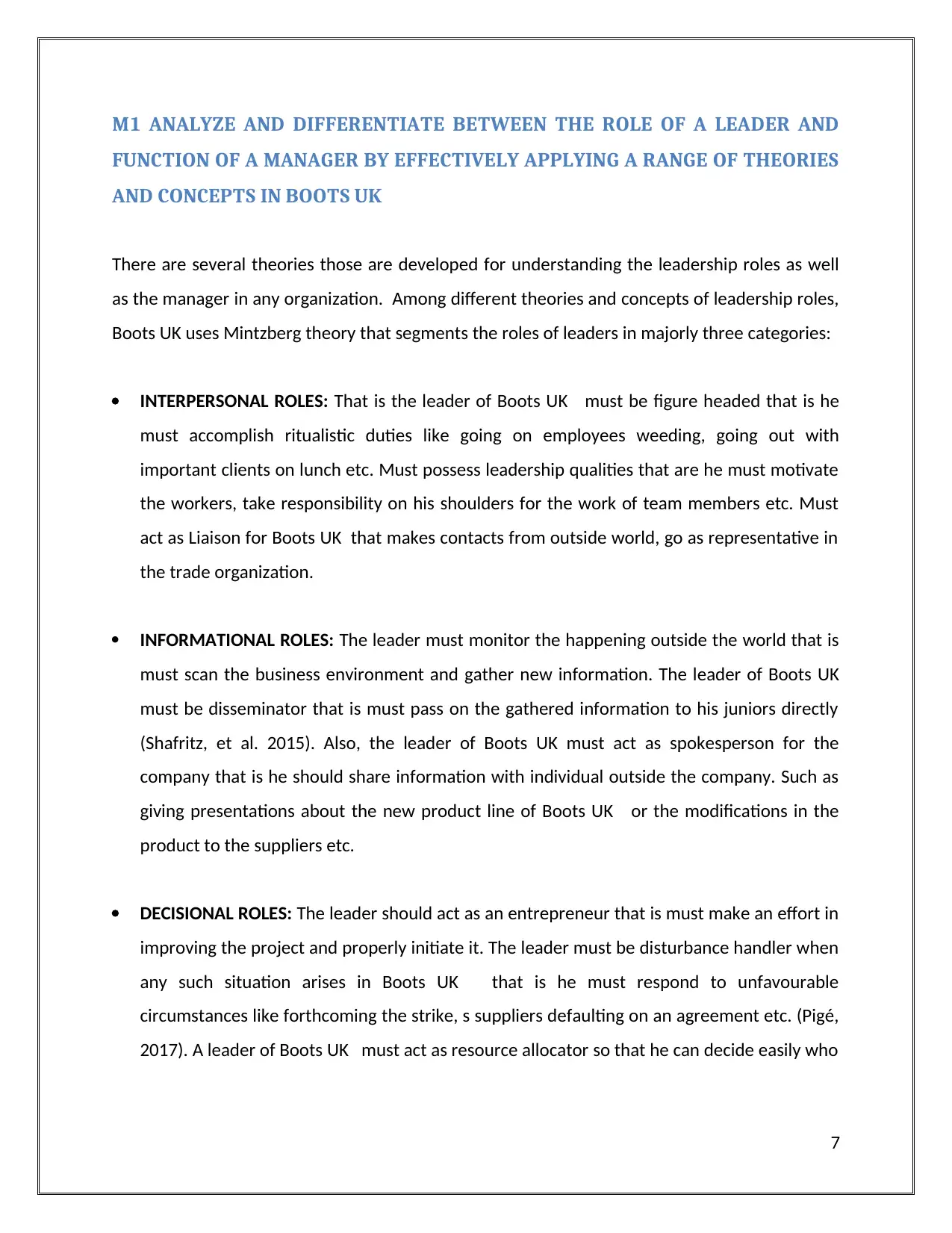
M1 ANALYZE AND DIFFERENTIATE BETWEEN THE ROLE OF A LEADER AND
FUNCTION OF A MANAGER BY EFFECTIVELY APPLYING A RANGE OF THEORIES
AND CONCEPTS IN BOOTS UK
There are several theories those are developed for understanding the leadership roles as well
as the manager in any organization. Among different theories and concepts of leadership roles,
Boots UK uses Mintzberg theory that segments the roles of leaders in majorly three categories:
INTERPERSONAL ROLES: That is the leader of Boots UK must be figure headed that is he
must accomplish ritualistic duties like going on employees weeding, going out with
important clients on lunch etc. Must possess leadership qualities that are he must motivate
the workers, take responsibility on his shoulders for the work of team members etc. Must
act as Liaison for Boots UK that makes contacts from outside world, go as representative in
the trade organization.
INFORMATIONAL ROLES: The leader must monitor the happening outside the world that is
must scan the business environment and gather new information. The leader of Boots UK
must be disseminator that is must pass on the gathered information to his juniors directly
(Shafritz, et al. 2015). Also, the leader of Boots UK must act as spokesperson for the
company that is he should share information with individual outside the company. Such as
giving presentations about the new product line of Boots UK or the modifications in the
product to the suppliers etc.
DECISIONAL ROLES: The leader should act as an entrepreneur that is must make an effort in
improving the project and properly initiate it. The leader must be disturbance handler when
any such situation arises in Boots UK that is he must respond to unfavourable
circumstances like forthcoming the strike, s suppliers defaulting on an agreement etc. (Pigé,
2017). A leader of Boots UK must act as resource allocator so that he can decide easily who
7
FUNCTION OF A MANAGER BY EFFECTIVELY APPLYING A RANGE OF THEORIES
AND CONCEPTS IN BOOTS UK
There are several theories those are developed for understanding the leadership roles as well
as the manager in any organization. Among different theories and concepts of leadership roles,
Boots UK uses Mintzberg theory that segments the roles of leaders in majorly three categories:
INTERPERSONAL ROLES: That is the leader of Boots UK must be figure headed that is he
must accomplish ritualistic duties like going on employees weeding, going out with
important clients on lunch etc. Must possess leadership qualities that are he must motivate
the workers, take responsibility on his shoulders for the work of team members etc. Must
act as Liaison for Boots UK that makes contacts from outside world, go as representative in
the trade organization.
INFORMATIONAL ROLES: The leader must monitor the happening outside the world that is
must scan the business environment and gather new information. The leader of Boots UK
must be disseminator that is must pass on the gathered information to his juniors directly
(Shafritz, et al. 2015). Also, the leader of Boots UK must act as spokesperson for the
company that is he should share information with individual outside the company. Such as
giving presentations about the new product line of Boots UK or the modifications in the
product to the suppliers etc.
DECISIONAL ROLES: The leader should act as an entrepreneur that is must make an effort in
improving the project and properly initiate it. The leader must be disturbance handler when
any such situation arises in Boots UK that is he must respond to unfavourable
circumstances like forthcoming the strike, s suppliers defaulting on an agreement etc. (Pigé,
2017). A leader of Boots UK must act as resource allocator so that he can decide easily who
7
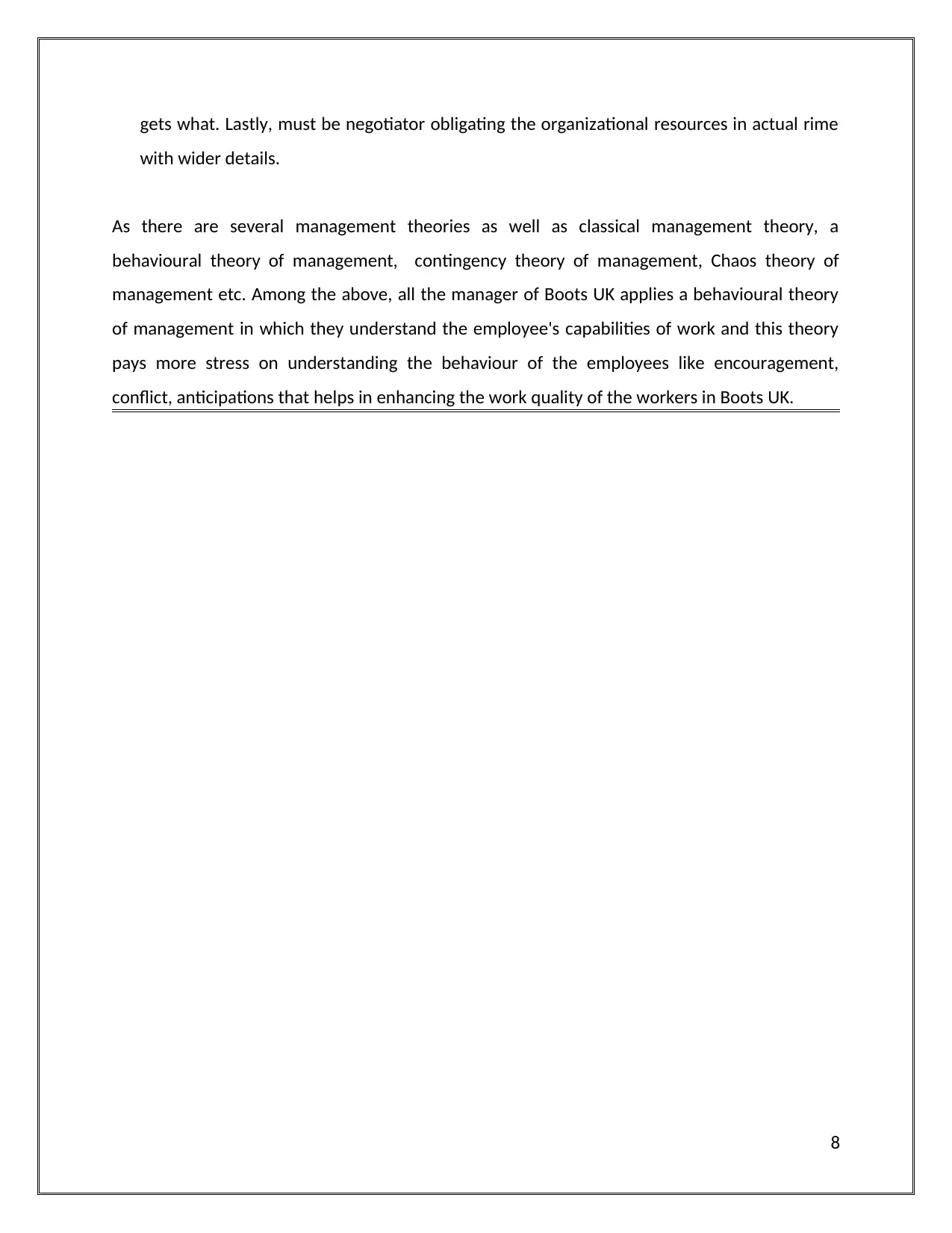
gets what. Lastly, must be negotiator obligating the organizational resources in actual rime
with wider details.
As there are several management theories as well as classical management theory, a
behavioural theory of management, contingency theory of management, Chaos theory of
management etc. Among the above, all the manager of Boots UK applies a behavioural theory
of management in which they understand the employee's capabilities of work and this theory
pays more stress on understanding the behaviour of the employees like encouragement,
conflict, anticipations that helps in enhancing the work quality of the workers in Boots UK.
8
with wider details.
As there are several management theories as well as classical management theory, a
behavioural theory of management, contingency theory of management, Chaos theory of
management etc. Among the above, all the manager of Boots UK applies a behavioural theory
of management in which they understand the employee's capabilities of work and this theory
pays more stress on understanding the behaviour of the employees like encouragement,
conflict, anticipations that helps in enhancing the work quality of the workers in Boots UK.
8
⊘ This is a preview!⊘
Do you want full access?
Subscribe today to unlock all pages.

Trusted by 1+ million students worldwide
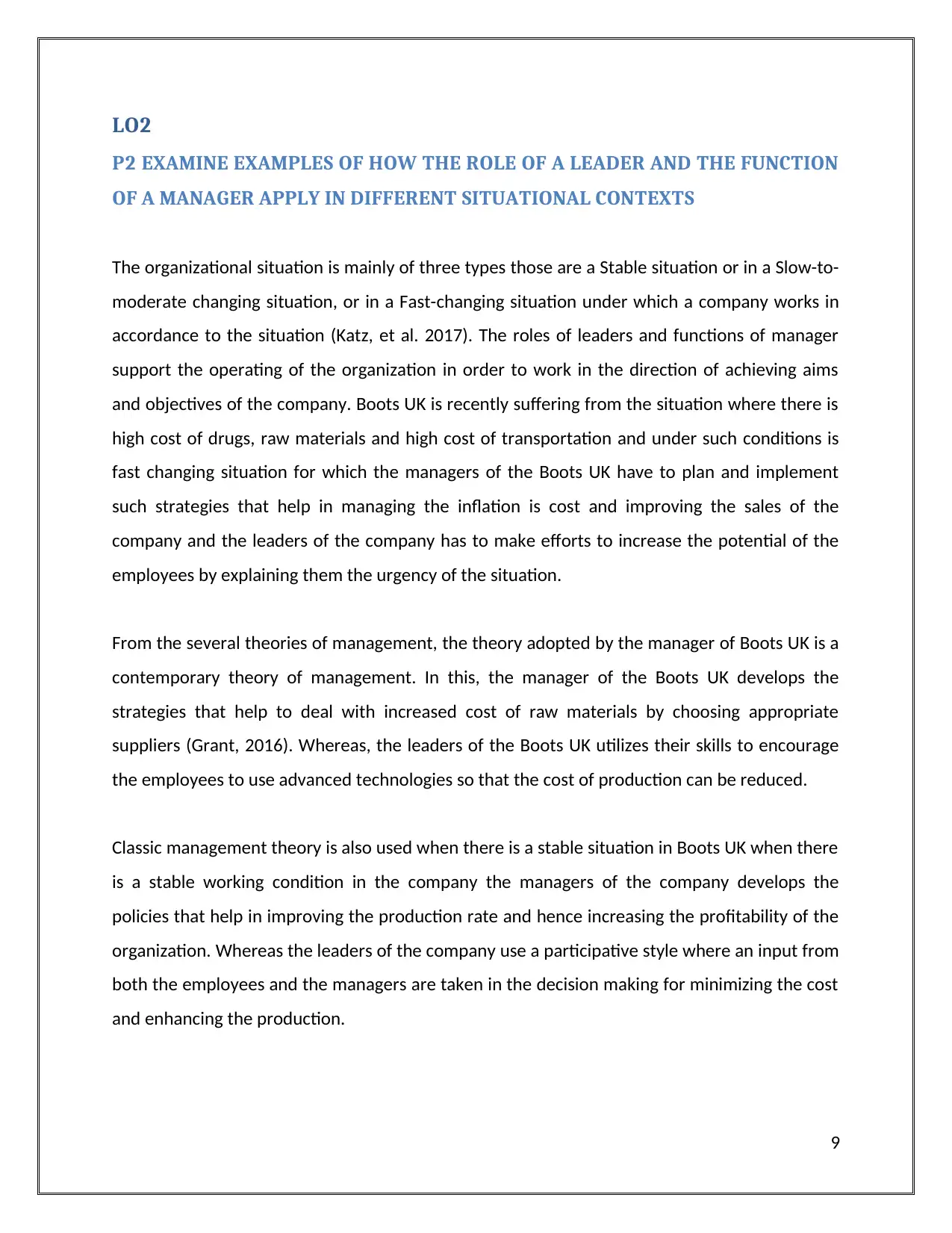
LO2
P2 EXAMINE EXAMPLES OF HOW THE ROLE OF A LEADER AND THE FUNCTION
OF A MANAGER APPLY IN DIFFERENT SITUATIONAL CONTEXTS
The organizational situation is mainly of three types those are a Stable situation or in a Slow-to-
moderate changing situation, or in a Fast-changing situation under which a company works in
accordance to the situation (Katz, et al. 2017). The roles of leaders and functions of manager
support the operating of the organization in order to work in the direction of achieving aims
and objectives of the company. Boots UK is recently suffering from the situation where there is
high cost of drugs, raw materials and high cost of transportation and under such conditions is
fast changing situation for which the managers of the Boots UK have to plan and implement
such strategies that help in managing the inflation is cost and improving the sales of the
company and the leaders of the company has to make efforts to increase the potential of the
employees by explaining them the urgency of the situation.
From the several theories of management, the theory adopted by the manager of Boots UK is a
contemporary theory of management. In this, the manager of the Boots UK develops the
strategies that help to deal with increased cost of raw materials by choosing appropriate
suppliers (Grant, 2016). Whereas, the leaders of the Boots UK utilizes their skills to encourage
the employees to use advanced technologies so that the cost of production can be reduced.
Classic management theory is also used when there is a stable situation in Boots UK when there
is a stable working condition in the company the managers of the company develops the
policies that help in improving the production rate and hence increasing the profitability of the
organization. Whereas the leaders of the company use a participative style where an input from
both the employees and the managers are taken in the decision making for minimizing the cost
and enhancing the production.
9
P2 EXAMINE EXAMPLES OF HOW THE ROLE OF A LEADER AND THE FUNCTION
OF A MANAGER APPLY IN DIFFERENT SITUATIONAL CONTEXTS
The organizational situation is mainly of three types those are a Stable situation or in a Slow-to-
moderate changing situation, or in a Fast-changing situation under which a company works in
accordance to the situation (Katz, et al. 2017). The roles of leaders and functions of manager
support the operating of the organization in order to work in the direction of achieving aims
and objectives of the company. Boots UK is recently suffering from the situation where there is
high cost of drugs, raw materials and high cost of transportation and under such conditions is
fast changing situation for which the managers of the Boots UK have to plan and implement
such strategies that help in managing the inflation is cost and improving the sales of the
company and the leaders of the company has to make efforts to increase the potential of the
employees by explaining them the urgency of the situation.
From the several theories of management, the theory adopted by the manager of Boots UK is a
contemporary theory of management. In this, the manager of the Boots UK develops the
strategies that help to deal with increased cost of raw materials by choosing appropriate
suppliers (Grant, 2016). Whereas, the leaders of the Boots UK utilizes their skills to encourage
the employees to use advanced technologies so that the cost of production can be reduced.
Classic management theory is also used when there is a stable situation in Boots UK when there
is a stable working condition in the company the managers of the company develops the
policies that help in improving the production rate and hence increasing the profitability of the
organization. Whereas the leaders of the company use a participative style where an input from
both the employees and the managers are taken in the decision making for minimizing the cost
and enhancing the production.
9
Paraphrase This Document
Need a fresh take? Get an instant paraphrase of this document with our AI Paraphraser
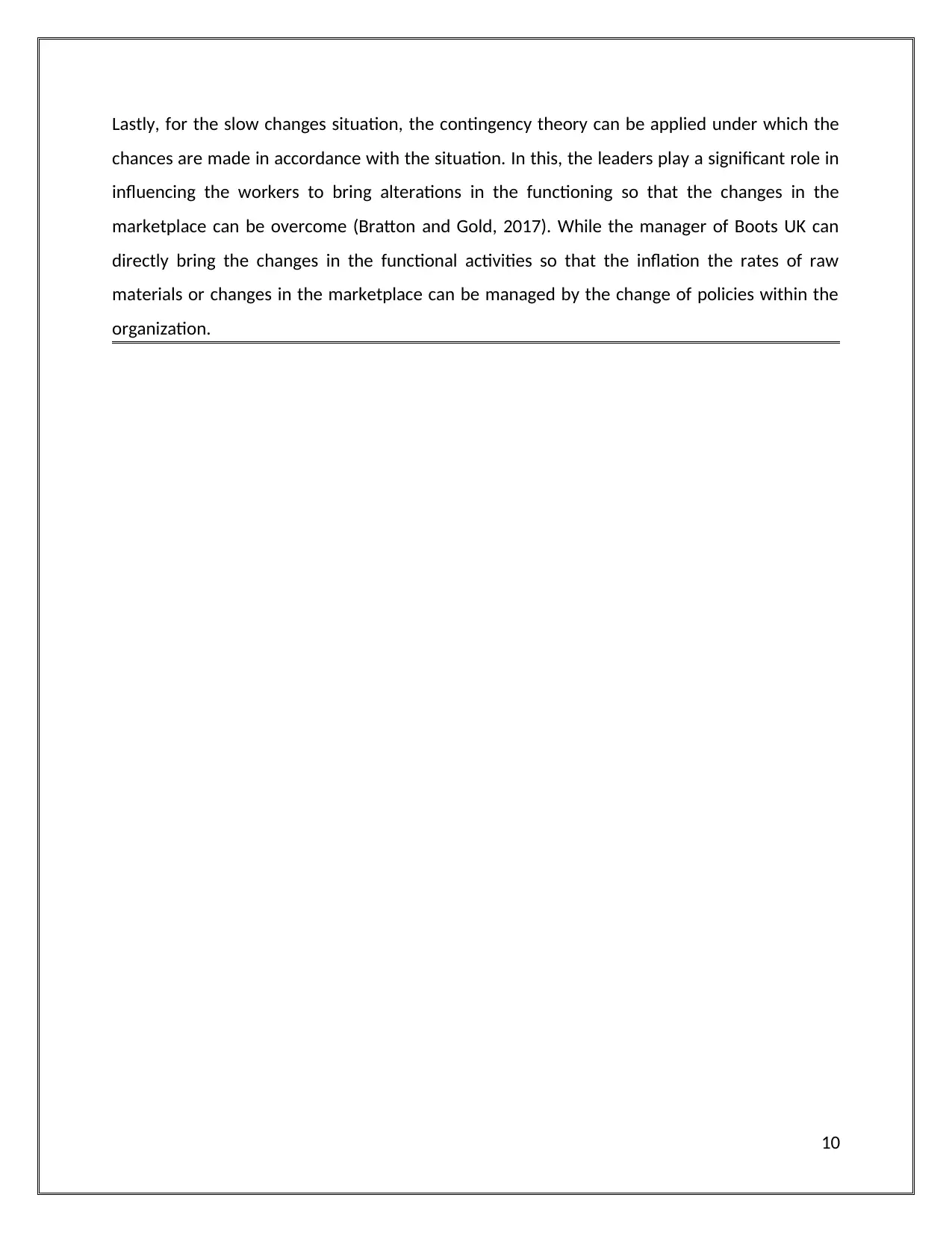
Lastly, for the slow changes situation, the contingency theory can be applied under which the
chances are made in accordance with the situation. In this, the leaders play a significant role in
influencing the workers to bring alterations in the functioning so that the changes in the
marketplace can be overcome (Bratton and Gold, 2017). While the manager of Boots UK can
directly bring the changes in the functional activities so that the inflation the rates of raw
materials or changes in the marketplace can be managed by the change of policies within the
organization.
10
chances are made in accordance with the situation. In this, the leaders play a significant role in
influencing the workers to bring alterations in the functioning so that the changes in the
marketplace can be overcome (Bratton and Gold, 2017). While the manager of Boots UK can
directly bring the changes in the functional activities so that the inflation the rates of raw
materials or changes in the marketplace can be managed by the change of policies within the
organization.
10
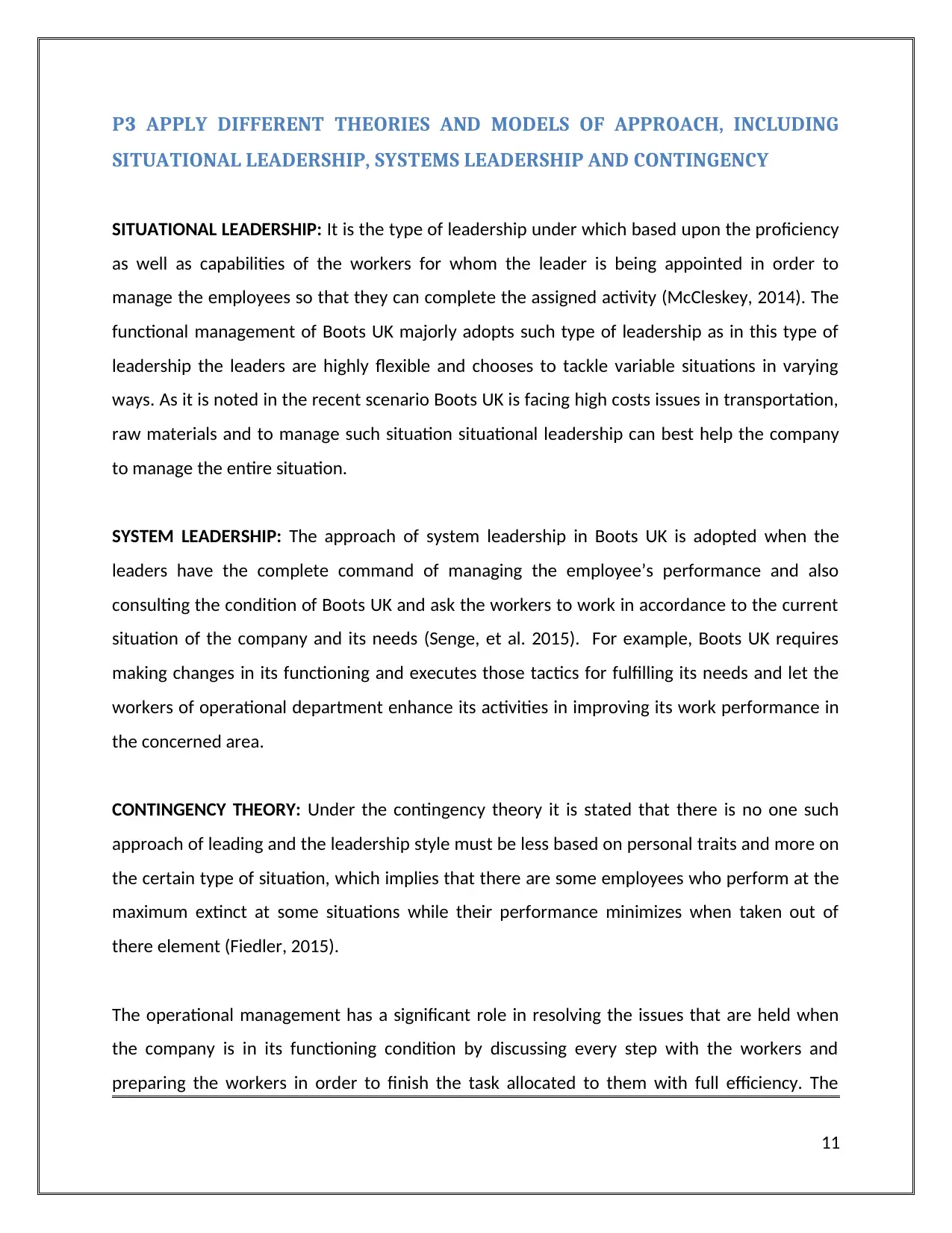
P3 APPLY DIFFERENT THEORIES AND MODELS OF APPROACH, INCLUDING
SITUATIONAL LEADERSHIP, SYSTEMS LEADERSHIP AND CONTINGENCY
SITUATIONAL LEADERSHIP: It is the type of leadership under which based upon the proficiency
as well as capabilities of the workers for whom the leader is being appointed in order to
manage the employees so that they can complete the assigned activity (McCleskey, 2014). The
functional management of Boots UK majorly adopts such type of leadership as in this type of
leadership the leaders are highly flexible and chooses to tackle variable situations in varying
ways. As it is noted in the recent scenario Boots UK is facing high costs issues in transportation,
raw materials and to manage such situation situational leadership can best help the company
to manage the entire situation.
SYSTEM LEADERSHIP: The approach of system leadership in Boots UK is adopted when the
leaders have the complete command of managing the employee’s performance and also
consulting the condition of Boots UK and ask the workers to work in accordance to the current
situation of the company and its needs (Senge, et al. 2015). For example, Boots UK requires
making changes in its functioning and executes those tactics for fulfilling its needs and let the
workers of operational department enhance its activities in improving its work performance in
the concerned area.
CONTINGENCY THEORY: Under the contingency theory it is stated that there is no one such
approach of leading and the leadership style must be less based on personal traits and more on
the certain type of situation, which implies that there are some employees who perform at the
maximum extinct at some situations while their performance minimizes when taken out of
there element (Fiedler, 2015).
The operational management has a significant role in resolving the issues that are held when
the company is in its functioning condition by discussing every step with the workers and
preparing the workers in order to finish the task allocated to them with full efficiency. The
11
SITUATIONAL LEADERSHIP, SYSTEMS LEADERSHIP AND CONTINGENCY
SITUATIONAL LEADERSHIP: It is the type of leadership under which based upon the proficiency
as well as capabilities of the workers for whom the leader is being appointed in order to
manage the employees so that they can complete the assigned activity (McCleskey, 2014). The
functional management of Boots UK majorly adopts such type of leadership as in this type of
leadership the leaders are highly flexible and chooses to tackle variable situations in varying
ways. As it is noted in the recent scenario Boots UK is facing high costs issues in transportation,
raw materials and to manage such situation situational leadership can best help the company
to manage the entire situation.
SYSTEM LEADERSHIP: The approach of system leadership in Boots UK is adopted when the
leaders have the complete command of managing the employee’s performance and also
consulting the condition of Boots UK and ask the workers to work in accordance to the current
situation of the company and its needs (Senge, et al. 2015). For example, Boots UK requires
making changes in its functioning and executes those tactics for fulfilling its needs and let the
workers of operational department enhance its activities in improving its work performance in
the concerned area.
CONTINGENCY THEORY: Under the contingency theory it is stated that there is no one such
approach of leading and the leadership style must be less based on personal traits and more on
the certain type of situation, which implies that there are some employees who perform at the
maximum extinct at some situations while their performance minimizes when taken out of
there element (Fiedler, 2015).
The operational management has a significant role in resolving the issues that are held when
the company is in its functioning condition by discussing every step with the workers and
preparing the workers in order to finish the task allocated to them with full efficiency. The
11
⊘ This is a preview!⊘
Do you want full access?
Subscribe today to unlock all pages.

Trusted by 1+ million students worldwide
1 out of 27
Related Documents
Your All-in-One AI-Powered Toolkit for Academic Success.
+13062052269
info@desklib.com
Available 24*7 on WhatsApp / Email
![[object Object]](/_next/static/media/star-bottom.7253800d.svg)
Unlock your academic potential
Copyright © 2020–2025 A2Z Services. All Rights Reserved. Developed and managed by ZUCOL.



